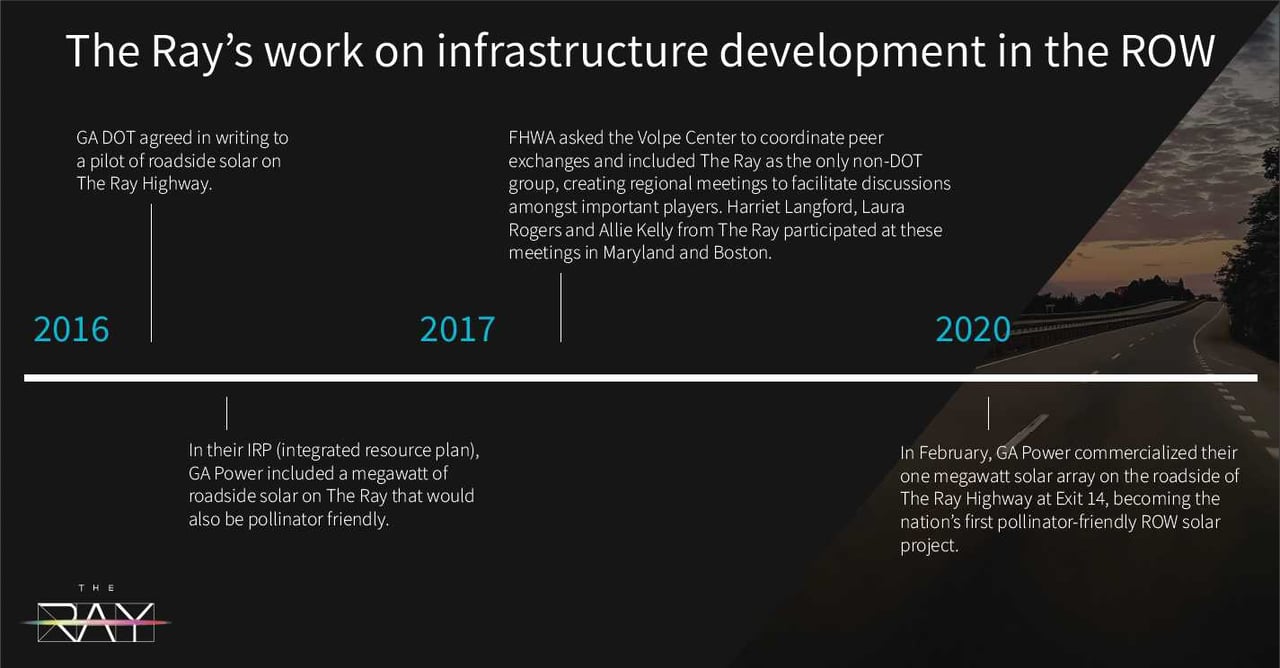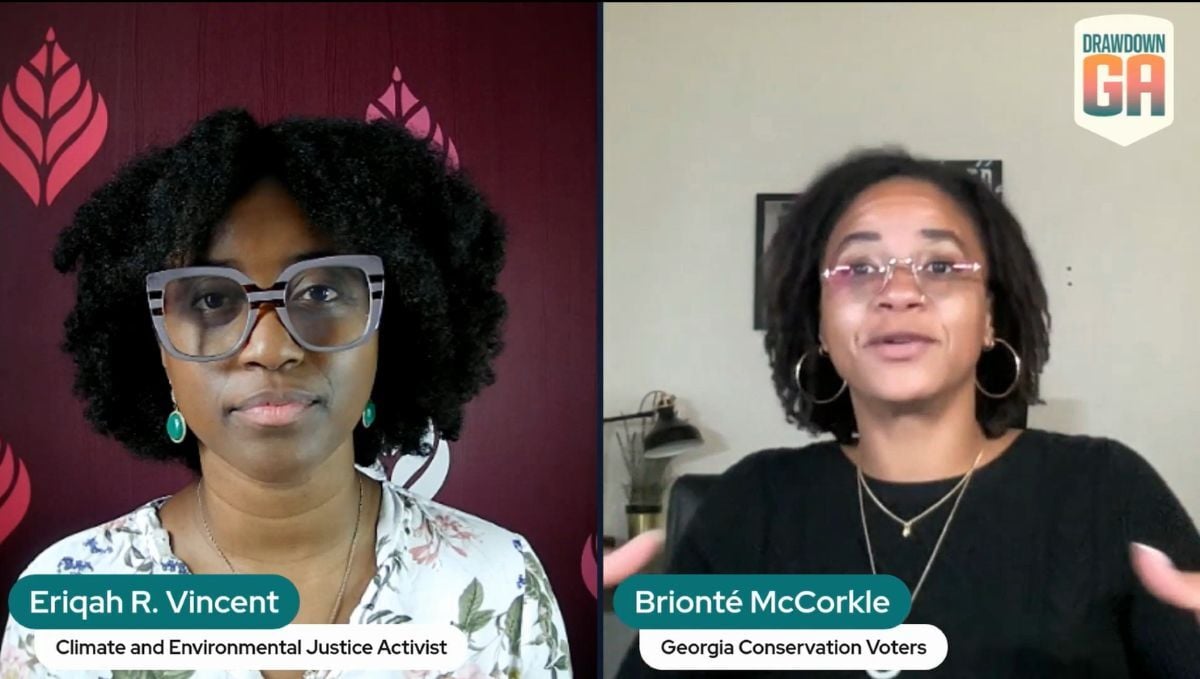Zero carbon. Zero waste. Zero deaths. At The Ray, we’re on a mission to pioneer smart, sustainable highways. It begins with an 18-mile stretch of interstate named in memory of Ray C. Anderson (1934-2011), a Georgia native who became the world’s leader in green business when he challenged his company, Interface, Inc., to pursue a zero environmental footprint. Chaired by Ray’s daughter Harriet Langford, The Ray is an epiphany of the Ray C. Anderson Foundation.
At Interface, Ray traveled a path he never imagined, all because he had the courage to ask, ’What if?’ That question, and the answers to which it led, changed the world and ignited a global movement toward sustainable business practice, proving that a better way is possible.

The Ray is the next leap in that journey, born of the same question: What if we start over and reimagine the way we connect our communities, our lives, and our world in a way that’s safer, more responsive to the climate, more regenerative to the environment, more uplifting to the spirit, and more capable of generating economic opportunity—today and for generations?
What is a sustainable highway?
We’re not just talking about what a sustainable highway could be. We are building it on a stretch of Interstate 85 (I-85) known as The Ray Highway, in West Georgia where Ray built his company and his life. By innovating from the ground up, we’ve created a testbed for the evolving ideas and technologies that will transform our transportation infrastructure.
At The Ray, we accomplish our mission through public-private-philanthropic partnerships (P4) to help mitigate risks and enable local, state, and federal governments to try new technologies and innovations in transportation and to quickly scale the technologies that can perform and succeed.
With transportation leading all other sectors in the U.S. economy in greenhouse gas emissions, the nation’s highway and road systems are not only disrupted by connected, autonomous, and electric vehicle technology, but also by the staggering complexity and urgency of the decarbonization challenge. Americans choose their vehicles, commutes, and driving patterns. Unlike the energy sector, the pathway to decarbonizing transportation in the short term is not entirely about (tailpipe) emissions.
How can we use the right-of-way to power change?
Some solutions actually lie, as if in waiting, in our highways' most underutilized asset - the roadsides. The lower 48 states have over 52,000 acres of empty roadside land at interstate exits, known as right-of-way (ROW). This land area is suitable for renewable energy development, and building solar arrays at the exits alone could generate up to 36 terawatt hours (TWh) a year - enough energy to power 12 million passenger electric vehicles (EVs).
Over the last six years, our team has built a model for a consistent utilization of the ROW focused on integrating energy and transportation infrastructure for clean energy generation and transmission while maintaining rigorous safety standards for travelers. Roadside solar is just the beginning. The “Next Generation Highways” model sets a standard for best practices to modernize, green, and secure our nation’s electric grid, integrate fiber for communications, and support the development of renewables - all on the ROW.
The Ray’s all-hands-on-deck approach to sustainable highways also recognizes that native grasses and pollinator plants, and even non-native, perennial Kernza®, can draw down carbon into roadside soils. Restoring degraded land, like the ROW, increases the carbon sequestration capability of the soils. Swapping out mowed grass on the roadsides for perennial grass and pollinator meadows - natural infrastructure - and specifying pollinator-friendly groundcovers for solar arrays can return multiple benefits: soil and habitat regeneration, natural carbon sequestration, and better stormwater management.

The Ray is Showing the Way
The Ray has been leading the charge to bring enhanced ROW utilization to the forefront of highway innovation, and we have been working with state agencies and partners that share our same vision. Beginning in 2016 with the idea of a ROW solar project on The Ray Highway, Georgia’s Department of Transportation (GDOT) joined the effort and signaled their willingness to partner. That same year, the Georgia Public Service Commission (PSC) debated and fine-tuned the 2016 “Integrated Resource Plan” of the state’s largest utility, Georgia Power. PSC Commissioner Tim Echols championed a megawatt of pollinator-friendly roadside solar for The Ray Highway in the utility’s plan, a dual-use project that utilizes the solar site’s ground cover - on DOT land - for growing pollinator habitat that benefits local agriculture.
Just one year later in 2017, the Federal Highway Administration (FHWA) asked the Volpe Center to coordinate peer exchanges across the country to facilitate discussions amongst key players in the advancement of highway technology. A team from The Ray was invited to the table as the only non-DOT group, and State DOT representatives included John Hibbard from GDOT, and our own Laura Rogers, who had been the architect of the Maryland DOT statewide solar program.
Back in Georgia, more than three years after the project was approved by GDOT and the PSC, Georgia Power commercialized The Ray’s one-megawatt solar array in February of 2020 at one triangle of the diamond interchange on I-85, at Exit 14. The project established the first pollinator-friendly ROW solar project in the U.S.
Transforming the U.S. Transportation Infrastructure
Today, we see the fruits of our labor and inspiration from that same project pay off on a national scale. FHWA and the U.S. Department of Transportation (USDOT) released guidance in April urging State DOTs to utilize our nation’s highway ROW land to support alternative uses that address crucial public needs, specifically citing renewable energy generation, new transmission, broadband, groundcover management, inductive charging in travel lanes, and EV charging stations.
With the support of the federal government, and our GIS mapping partnership with Esri, The Ray has the capability to provide training, technical assistance, and consulting for transportation and state agencies across the country. It is time to transform thousands of acres of empty ROW to create a highway system that restores our environment and the world. Now, let’s drive the future.









